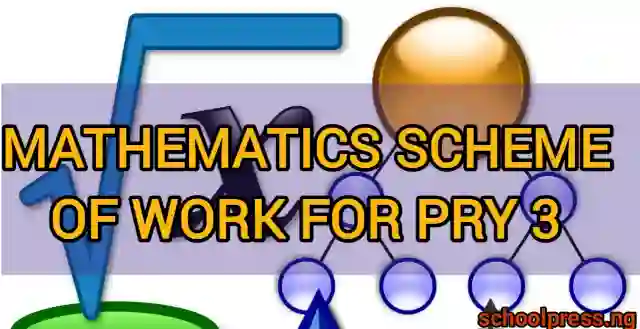One of the most significant subjects pupils in primary school must learn is mathematics. The subject contributes to the development of students’ logical and analytical thinking and allows them to solve a variety of problems while in school and the field. The Mathematics Scheme of Work for Primary 3 pupils is thus very vital.
The scheme of work is a detailed curriculum that provides teachers with structured information on lessons that should be delivered to pupils and ways of teaching. This involves delivering the mathematics curriculum to pupils in Primary 3. Generally, pupils in this level are approximately 7-8 years old. Since one is relatively young, they are still in the early stages of cognitive development. Therefore, this curriculum must be well arranged to acquire a proper understanding of the concept.
The Mathematics Scheme of Work for Primary 3 is developed to ensure that pupils have a good grounding in mathematics. Pupils are taught basic concepts such as addition and subtraction, multiplication, division and fractions. Other concepts such as geometry, understanding and analyzing graphical data and measuring are also included in this scheme. The methods of teaching are also fun, and interactive to ensure that pupils remain active throughout the lesson.
The lesson plan spans several units, each related to a particular topic. Thus, the first unit can be oriented around addition and subtraction. It will contain the lesson plan the teacher will be shown how to teach pupils to add and subtract numbers, what type of activities and exercises they need to do to improve this skill and many others. The next will be oriented around multiplication and division etc.
Furthermore, the scheme of work is designed to ensure that pupils are progressing at their rates. The curriculum is set such that they have a clear understanding of each lesson independently before they can start another. It builds confidence that they will handle the math problems which are very important as far as learning is concerned.
The scheme provides a structure through which the teachers can help in assessing the pupils’ progress: this scheme comes with specific assessment tools and techniques that the teachers can use to assess the pupils’ understanding of the covered topics in each unit. By identifying the areas that the students are struggling in, the students can be helped through targeted support.
The Mathematics Scheme of Work for Primary 3 pupils is an essential tool in teaching mathematics to primary school pupils. The scheme presents a systematic curriculum on the subject, tailored to the needs of the pupils at this stage, which is essential for their learning. For this reason, the teachers must adhere to the scheme and execute the curriculum effectively and ensure pupils get the best education in mathematics.
Table of Contents
First Term Mathematics Scheme of Work for Primary 3
| WEEK | TOPIC | CONTENT |
| 1 | Whole numbers up to 999. | Correct counting of numbers up to 999. reading of numbers up to 999. writing of numbers up to 999. |
| 2. | Whole number up to 999. (Place Value) | Counting in groups of Hundreds, Tens and Units (H T U). |
| 3. | Whole numbers up to 999. | Reading statement of inequality using the symbols < and >. Ordering whole numbers with symbols < and >. Comparison of numbers and the use of the expression greater than or less than. |
| 4. | Fractions | Fractions (1/2, 1/3, %, 1/5, 1/6). Fractions of shapes, square, circle, rectangle and triangle. Fractions as a part of collections. |
| 5. | Fractions | Equivalent fractions A = 2/4 = 3/6 etc. Ordering of fractions. |
| 6. | Addition | Subtraction of 2- 2-digit numbers with exchanging or renaming. Subtraction of 3- 3-digit numbers with renaming. Subtraction of 3 numbers taking two at a time. |
| 7. | Mid Term Test | |
| 8. | Addition | Addition of fractions with the same denominators. |
| 9. | Subtraction | Addition of 2-digit numbers with exchanging or renaming. Addition of 3- digit numbers with renaming. Addition of 3 numbers taking two at a time. |
| 10. | Subtraction of 2-digit numbers with exchanging or renaming. Subtraction of 3-digit numbers with renaming. Subtraction of 3 numbers taking two at a time. | |
| 11. | Revision | |
| 12 & 13 | Examination |
Check All Primary Schemes of Work Below
Second Term Mathematics Scheme of Work for Primary 3
| WEEK | TOPIC | CONTENT |
| 1 | Multiplication | Basic multiplication from: 1 x 1 to 9 x 9. Multiplication of 2-digit number by 1¬digit e.g. 23 x 4 = 92 |
| 2. | Multiplication of three 1-digit number taking two at a time. e.g. 7 x 8 x 9 = (7×8) x9 56×9 =504 | |
| 3. | Division | Division of whole numbers not exceeding 48 by 2,3,4,5, and 6 without remainder. Factors of whole numbers not exceeding 48. |
| 4. | Finding a missing factor in a given number. Factors and multiples of numbers | |
| 5. | Open sentences | Open sentences |
| 6. | Money | Changing money not exceeding N100 into smaller units. Shopping involving addition with money not greater than N100 |
| 7. | Mid Term Test | |
| 8. | Money Cont. | 1. Shopping involving subtraction with not greater than N100. 2. Multiplication involving money with production not exceeding N100. |
| 9. | Length | Multiplication of three 1-digit numbers taking two at a time. e.g. 7 x 8 x 9 = (7×8) x9 56×9 =504 |
| 10. | Length Cont. | 1. Measure lengths, widths and comparison of estimate with actual measurement using steps and hand span. ii. Measuring and finding the perimeter of regular figures in metres and centimetres. |
| 11. | Revision | |
| 12 & 13 | Examination |
Check All Jss Scheme Of Work Bellow
Third Term Mathematics Scheme of Work for Primary 3
| WEEK | TOPIC | CONTENT |
| 1 | Time | Time on the clock |
| 2. | Calendar | Calendar reading of the days of the months, years and reading of dates. |
| 3. | Weight | Introduction of grammes and kilogrammes as units of measurement. |
| 4. | Weights of some objects | |
| 5. | Capacity | Identify litres as a unit of measuring capacity. Measuring liquid e.g. water with a graduated cylinder up to any stated number of litres. |
| 6. | Symmetry (shapes) | Line(s) of symmetry. Properties of: *squares *Rectangles *Triangles |
| 7. | Mid Term Test | |
| 8. | Symmetry (Shapes) Cont. | Curves and straight lines. Drawing of squares, rectangles, triangles and circles. |
| 9-10 | Pictograms and mode | Pictograms, Pictograms and mode. |
| 11. | Revision | |
| 12 & 13 | Examination |
Check All SSS Scheme Of Work Bellow
Conclusion
The scheme of work’s purpose is to prepare learners with the requisite skills and knowledge needed to excel in mathematics. The scheme of work for Primary 3 is meant to continue what has been put down in Primary 2 and introduce the learners to new concepts. The main scheme of work is classified into the units based on the topics in mathematics.
These are Addition, Subtraction, Multiplication, Division, Fractions, Measurement, Time and Money. During the lesson, learners obtain an in-depth understanding of mathematics as a concept and have active experience to implement it in practical scenarios. They make use of practical activities, group work, problem-solving tasks, and others to elaborate critical thinking
The Mathematics Scheme of Work for Primary 3 is a good lesson with adequacy in developing learners to the required skills and knowledge for excelling in mathematics.
The scheme of work covers all necessary areas, and the learning environment provided is adequate to aid the learners’ internalization of the content through handling and problem-solving as a team. Under the facilitator’s guidance and support, learners can love the subject and develop a background for content mastery in later life.









